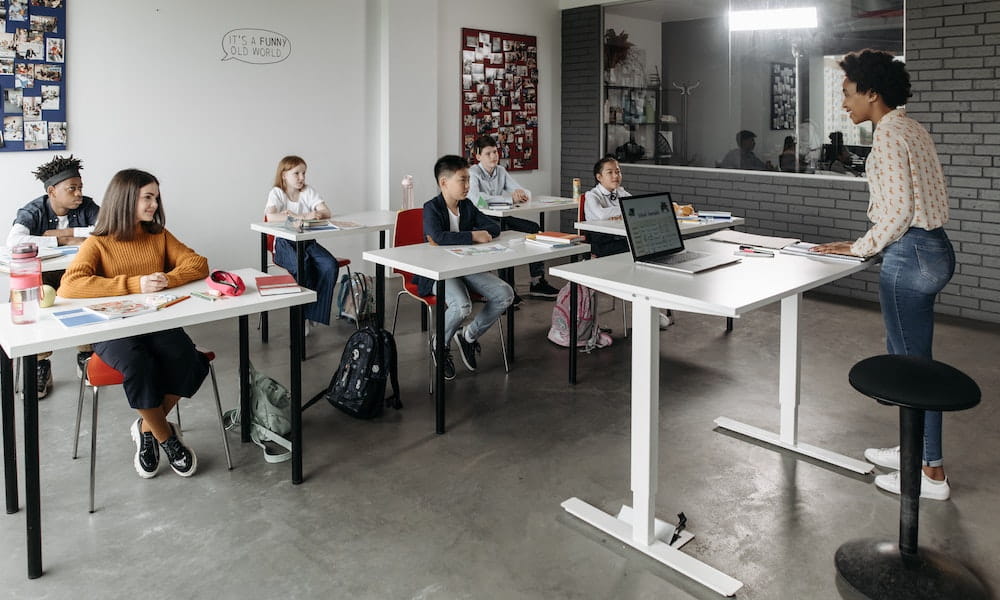- How to Use Your Standing Desk Correctly - February 4, 2024
- Why the Need for Standing Desks for Children & Teens - February 4, 2024
- 3 Types of Standing Desks Suitable for Home Use - February 4, 2024
Children and teens are spending more and more time sitting, whether it’s at school, at home, or on their devices. This sedentary lifestyle can lead to a number of health problems, including obesity, type 2 diabetes, and cardiovascular disease. Standing desks are a great way to combat sedentary behaviour and improve overall health.
A 2020 research conducted by Travis Saunders et al from the University of Prince Edward Island in Canada confirmed that sedentary behaviour is associated with depression, physical activity levels, cognitive function, and physical health-related quality of life. The negative health risks can be alleviated by reducing time spent sitting.
5 Health Benefits of Standing Desks for Youths
There is growing evidence to suggest that standing desks can have a number of health benefits for youths. Here are five of them (also in the image below):

1. Helps with Concentration
Children often have short attention spans and difficulty concentrating, which can make it difficult for them to learn in school. This can lead to poor grades and academic problems. Using a standing desk can help improve children’s focus and concentration.
This is because standing requires more physical activity than sitting, which helps to keep the brain alert. Standing desks also allow children to move around more, which can help to prevent boredom and restlessness.
If you are concerned about your child’s attention span or concentration, you may want to consider getting them a standing desk. This could help them to improve their academic performance and overall learning.
2. Encourages Good Posture
Long periods of sitting with poor posture can lead to back pain, neck pain, and other posture-related problems. Sitting for too long can cause your spine to curve and your shoulders to hunch forward.
Poor posture can be a serious problem for children, as their bodies are still growing and developing. Standing desks can help to improve posture by keeping your spine aligned and your
shoulders back. Using a standing desk can help to prevent posture problems and improve overall health.
3. Boosts Energy Expenditure
Although it is important to consider the energy expenditure of standing desks, it is even more important to consider the effects of prolonged standing on children. Some studies have shown that standing desks can lead to an increase in physical activity.
Instilling healthy habits in children is essential for them to become healthy and active adults. This is perhaps the most important benefit of standing desks in the long term, as healthy habits are formed in childhood.
4. Increases Calorie Burn
Standing desks were initially seen as a practical way to address the rising rates of childhood obesity. However, while standing does burn more calories than sitting, obesity is a complex issue that requires multiple lifestyle changes.
Early studies overestimated the number of calories burned by standing. More recent studies have found that standing only burns about 8 more calories per hour than sitting. However, a study from 2016 by B. Barone Gibbs at the University of Pittsburgh, Pennsylvania, USA using 18 subjects proved that a sit-stand desk increases energy expenditure.
While this may not seem like much, the other health benefits of standing are worth considering. Standing can help to improve circulation, reduce back pain, and boost energy levels.
5. Increase Blood Flow to the Brain
Lack of physical activity and mental stimulation can contribute to attention deficit hyperactivity disorder (ADHD) and attention deficit disorder (ADD), as well as other mental health problems such as anxiety and depression.
One of the benefits of using a standing desk for schoolwork is that it can provide mental stimulation and help improve concentration levels. It can also promote physical activity, which can boost the production of endorphins, which can help children feel happier and more content. This can lead to improved academic performance and overall well-being.

What Are the Potential Impacts on Children Not Using Standing Desks?
Excessive sitting can have serious health consequences for children. The following are some health consequences of prolonged sitting:
High cholesterol: Prolonged sitting can lead to high cholesterol levels, which is a risk factor for heart disease and stroke.
Diabetes: Prolonged sitting can increase the risk of developing type 2 diabetes, a chronic condition that affects the way the body uses sugar.
Obesity: Prolonged sitting can contribute to weight gain, which is a major risk factor for obesity.
High blood pressure: Prolonged sitting can increase blood pressure, which is another risk factor for heart disease and stroke.
Decreased cardiorespiratory fitness: Prolonged sitting can decrease cardiorespiratory fitness, which is the body’s ability to use oxygen. This can lead to fatigue and shortness of breath.
Why Should Children Use Ergonomic Furniture?
Ergonomic furniture for children is essential for supporting academic and physical growth. Ergonomic workstations can help children focus on their studies by providing a dedicated study space which can help them transition from play mode to work mode.
Study spaces with ergonomic chairs and desks can help children focus for extended periods. A clear desk free of toys, gadgets, and other distractions can help children stay focused on their work.
An ergonomic desk is a study area with plenty of storage space. This allows you to keep all learning materials in one place, which encourages your child’s organisational skills and instils a sense of responsibility.
Ergonomic chairs are designed to help people develop good posture habits. Learning to sit properly at a young age is important because poor posture can lead to chronic back pain, neck strain, and other health problems later in life.
Providing your child with a dedicated study space can help them develop good study habits and a sense of independence.
How to Choose the Right Standing Desk for Children or Teens?
Standing desks, also known as sit-stand desks, are adjustable desks that allow users to switch between sitting and standing. When choosing a sit-stand desk for a student, it is important to consider the desk’s durability, ease of cleaning, and ability to accommodate the child’s growth.
A sturdy steel base and high-pressure laminate work surface are both good choices for a durable and easy-to-clean desk.
There are many different styles of standing desks available, so it is important to consider the child’s needs and preferences when making a decision. For example, a mobile adjustable desk may be ideal for a classroom setting, while a height-adjustable corner desk or narrow standing desk may be a better choice for home use.

